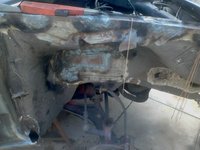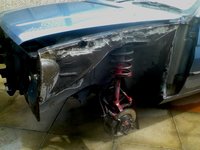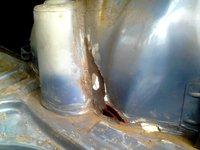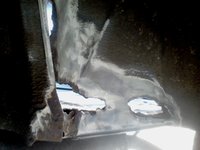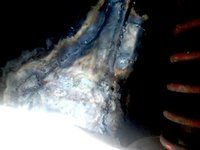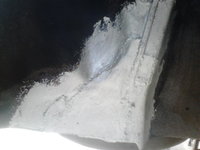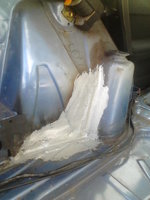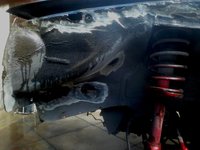You are using an out of date browser. It may not display this or other websites correctly.
You should upgrade or use an alternative browser.
You should upgrade or use an alternative browser.
Why do ducato's decompose?
- Thread starter oppy
- Start date
2cv
Full Member
- Posts
- 6,566
- Likes
- 17,475
My theory is that in the vast majority of cases they are used commercially and designed to have a hard but short life. Because motorhomes are relatively little used and relatively cosseted they generally have a much longer life and this is why corrosion becomes such a problem.
mistericeman
Full Member
- Posts
- 5,623
- Likes
- 13,150
Not just Ducatos,..... Pretty much Every vehicle I've ever owned...
Especially the landrovers ;-)






Especially the landrovers ;-)
colinm
Full Member
- Posts
- 5,820
- Likes
- 7,282
For those that don't know, most of the body on Ducato's have been galvanised for many years, for Sprinters this only happened relatively recently, not sure about Tranny's.
Go back a few decades, and all those 'simple easy to work on vehicles' where mostly a pile of rust after 10 years, more modern vehicles are much more resistant, but people are rarely interested in patching them up.
Go back a few decades, and all those 'simple easy to work on vehicles' where mostly a pile of rust after 10 years, more modern vehicles are much more resistant, but people are rarely interested in patching them up.
MartinFife
Full Member
- Posts
- 32
- Likes
- 65
The Boxer, Relay & Ducato vans were fully galvanised from 2007 model release & onwards. No doubt older ones will have their problems...
trevskoda
Full Member
- Posts
- 44,195
- Likes
- 66,326
Because when new some lazy fart did not bother to inject waxol or other rust preventer into all box sections.Just had a quote to repair potential m o t failures plus he accidentally stuck his hand into the inner cill whilst dragging himself from underneath..............£4 to 5 hundred squids, Sue will have to be back on the streets again!!!
oppy
Full Member
- Posts
- 4,207
- Likes
- 7,709
I learned my mig welding skills on our mk2 long wheel base Landy almost every weekend something needed to be stuck back on, mind you it is because of this landy an important lesson was learned, and that applies to a 25 year old Ducato based moho and that is---------if you can't hear it rattling, it's fallen offNot just Ducatos,..... Pretty much Every vehicle I've ever owned...
Especially the landrovers ;-)
View attachment 102518
View attachment 102519View attachment 102520View attachment 102521View attachment 102522View attachment 102523
mistericeman
Full Member
- Posts
- 5,623
- Likes
- 13,150
Try having 5 series landrovers AND a Ducato lolI learned my mig welding skills on our mk2 long wheel base Landy almost every weekend something needed to be stuck back on, mind you it is because of this landy an important lesson was learned, and that applies to a 25 year old Ducato based moho and that is---------if you can't hear it rattling, it's fallen off
oppy
Full Member
- Posts
- 4,207
- Likes
- 7,709
Sorry, I wasn't being subtle young grandson, it's just while the stuff was being sorted on the tin tent our tame mech got his buddy to destroy bits of the van. He was apprenticed to an ancient and dear friend way back when so his word is accepted, and I've just bought Sue a new handbag from Oxfam and tomorrow night she'll be back on her old beat...........grab a granny rules ok. Seriously though, there's no problem the current situation means that funds are available and if it gets to be a bit silly our likkle lad will help us outHelp is on it's way Peter, give me a couple of weeks to sort things out my end.
oppy
Full Member
- Posts
- 4,207
- Likes
- 7,709
Some folks never learnTry having 5 series landrovers AND a Ducato lol
Pauljenny
Full Member
- Posts
- 13,001
- Likes
- 27,789
We used to live overlooking the A56, at Altrincham.
There's a big scrap yard nearby, Jamie Davidson.
Flatbed trucks regularly pass, and I noticed that a fair proportion of vans were under 7 years old. Particularly Tesco and other retailers.
The manufacturers know this and build this in .
If they made them last for ever..
There'd be mass unemployment .
Ditto private cars.. Not many 10 year old Mercs and BMWs, gracing the Cheshire lanes.
There's a big scrap yard nearby, Jamie Davidson.
Flatbed trucks regularly pass, and I noticed that a fair proportion of vans were under 7 years old. Particularly Tesco and other retailers.
The manufacturers know this and build this in .
If they made them last for ever..
There'd be mass unemployment .
Ditto private cars.. Not many 10 year old Mercs and BMWs, gracing the Cheshire lanes.
oppy
Full Member
- Posts
- 4,207
- Likes
- 7,709
Our Kia Ce ed is now 11 years old with 61 and a bit thou on the clockWe used to live overlooking the A56, at Altrincham.
There's a big scrap yard nearby, Jamie Davidson.
Flatbed trucks regularly pass, and I noticed that a fair proportion of vans were under 7 years old. Particularly Tesco and other retailers.
The manufacturers know this and build this in .
If they made them last for ever..
There'd be mass unemployment .
Ditto private cars.. Not many 10 year old Mercs and BMWs, gracing the Cheshire lanes.
trevskoda
Full Member
- Posts
- 44,195
- Likes
- 66,326
Thats just a baby, 22 years old and had 314000 on the clockOur Kia Ce ed is now 11 years old with 61 and a bit thou on the clock
vindiboy
Full Member
- Posts
- 3,813
- Likes
- 4,280
I worked in the Ford Transit plant at Southampton for 31 years retiring early at 55 ,21 years ago, all transits were subjected to a rigorous rust prevention regime,
The completed body including hood and all doors was taken through a special degreasing tunnel where they were sprayed at high pressure and temperature with demineralised water , paraffin and degreasing agents , the bodies were then passed through a continuous tunnel of demineralised water to rinse them they were then subjected to further sprays that contained Phosphate an anti rust agent, the bodies then passed through huge ovens and wind tunnels to completely dry them this system took an hour in total on an endless conveyor.
On exit from these tunnels the bodies were hooked up to electrodes for the next stage of their journeys, which was to hoist each body to overhead conveyors for their next stage which was total immersion into huge tanks of red oxide electrocoating liquid paint , they remained submerged totally in this paint which was very fluid bubbling and moving so that it entered every hole crevices joint etc including flooding the complete chassis of the build.
An electric current was then passed through the bodies causing the electrocoat paint to adhere to every surface, the bodies were then hoisted out of the tanks [ all automatically I add ] and they got another rinse on their travel to the next stage which was gas fired ovens to bake and seal the paint, This system was a bottle neck in the production because we could only process 25 bodies an hour but could build bodies quicker, hence this area was a big overtime earner working days and nights 7 days a week to keep the plant working .
The first part of the process being finished the bodies [a mixture of chassis cabs complete vans both large and small diesel and petrol on final build] traveled overhead to the next part of the process which was the sealer deck, on this deck all holes in the chassis had metal plugs inserted and sealed and all the welded seams [spot welded] were sealed with special sealant, wheel arches internally were sealed with very viscous sealant , black , the roof joints were sealed with another sealer from high pressure hoses [manually by operatives] as was the whole body.
The bodies then passed to the first paint booths , the priming sprayers, this was a manual spraying booth later to become automatic, the bodies all got 2 complete coats of primer paint inside and out,
We then transported the bodies through giant ovens to bake the primer-paint covering all done on automatic transport lines, after exiting the primer ovens the bodies passed off line to a holding area to cool as they were too hot to touch,
After cooling the bodies [computer selected for type, urgency ,and availability of parts needed engine gearboxes transmissions clutches etc ] for the further build requirements, went through what we called the sanding deck where they were sanded wet and dry by operatives following attached cards put on by our inspection guys on any snags runs etc they had detected , the bodies were then manually tack ragged, a sticky lint free cloth that cleaned off any dust left after the manual petrol wipe down and sanding process, the bodies then passed through a sealed compartment for high pressure blow off to remove any dust that was still on the bodies, after this they passed into the final paint booths for spraying with their final colour [ manual spraying later automated ] and also to receive any bake on floor coverings etc, before entering the final ovens to have the paint baked and finished.
Final painted bodies then went to the underseal area where the were undersealed wax oiled if that was on the spec and then got a final inspection and any defects in the paint was sorted at an off line facility called the 2 tone booths where they received any repairs to paint considered needed and also to receive second colours if they were ordered as 2 tone colours etc,.
Bodies then moved to the trim lines building for fitting out with everything a vehicle needs or had specified at ordering, We in later years started galvanizing the interior or doors and the interior of hood tops as these places due to extra handling by white van men caused paint damage and allowed corrosion to impact these areas.
So in my opinion Transit based vehicles got excellent anti corrosion treatment throughout ?
We often had visitor tours of the plant and the most commented on area of the tour by visitors was what we called the DIPPER TANKS where we submerged the bodies for treatment , people were amazed to watch this process.
The completed body including hood and all doors was taken through a special degreasing tunnel where they were sprayed at high pressure and temperature with demineralised water , paraffin and degreasing agents , the bodies were then passed through a continuous tunnel of demineralised water to rinse them they were then subjected to further sprays that contained Phosphate an anti rust agent, the bodies then passed through huge ovens and wind tunnels to completely dry them this system took an hour in total on an endless conveyor.
On exit from these tunnels the bodies were hooked up to electrodes for the next stage of their journeys, which was to hoist each body to overhead conveyors for their next stage which was total immersion into huge tanks of red oxide electrocoating liquid paint , they remained submerged totally in this paint which was very fluid bubbling and moving so that it entered every hole crevices joint etc including flooding the complete chassis of the build.
An electric current was then passed through the bodies causing the electrocoat paint to adhere to every surface, the bodies were then hoisted out of the tanks [ all automatically I add ] and they got another rinse on their travel to the next stage which was gas fired ovens to bake and seal the paint, This system was a bottle neck in the production because we could only process 25 bodies an hour but could build bodies quicker, hence this area was a big overtime earner working days and nights 7 days a week to keep the plant working .
The first part of the process being finished the bodies [a mixture of chassis cabs complete vans both large and small diesel and petrol on final build] traveled overhead to the next part of the process which was the sealer deck, on this deck all holes in the chassis had metal plugs inserted and sealed and all the welded seams [spot welded] were sealed with special sealant, wheel arches internally were sealed with very viscous sealant , black , the roof joints were sealed with another sealer from high pressure hoses [manually by operatives] as was the whole body.
The bodies then passed to the first paint booths , the priming sprayers, this was a manual spraying booth later to become automatic, the bodies all got 2 complete coats of primer paint inside and out,
We then transported the bodies through giant ovens to bake the primer-paint covering all done on automatic transport lines, after exiting the primer ovens the bodies passed off line to a holding area to cool as they were too hot to touch,
After cooling the bodies [computer selected for type, urgency ,and availability of parts needed engine gearboxes transmissions clutches etc ] for the further build requirements, went through what we called the sanding deck where they were sanded wet and dry by operatives following attached cards put on by our inspection guys on any snags runs etc they had detected , the bodies were then manually tack ragged, a sticky lint free cloth that cleaned off any dust left after the manual petrol wipe down and sanding process, the bodies then passed through a sealed compartment for high pressure blow off to remove any dust that was still on the bodies, after this they passed into the final paint booths for spraying with their final colour [ manual spraying later automated ] and also to receive any bake on floor coverings etc, before entering the final ovens to have the paint baked and finished.
Final painted bodies then went to the underseal area where the were undersealed wax oiled if that was on the spec and then got a final inspection and any defects in the paint was sorted at an off line facility called the 2 tone booths where they received any repairs to paint considered needed and also to receive second colours if they were ordered as 2 tone colours etc,.
Bodies then moved to the trim lines building for fitting out with everything a vehicle needs or had specified at ordering, We in later years started galvanizing the interior or doors and the interior of hood tops as these places due to extra handling by white van men caused paint damage and allowed corrosion to impact these areas.
So in my opinion Transit based vehicles got excellent anti corrosion treatment throughout ?
We often had visitor tours of the plant and the most commented on area of the tour by visitors was what we called the DIPPER TANKS where we submerged the bodies for treatment , people were amazed to watch this process.

